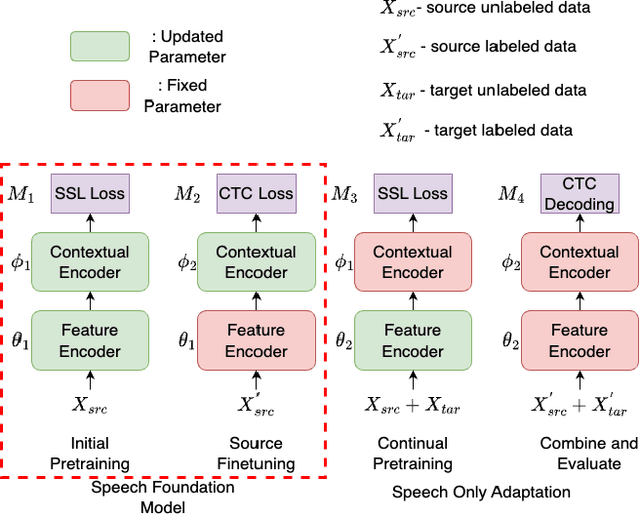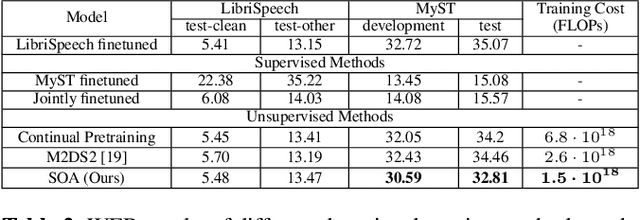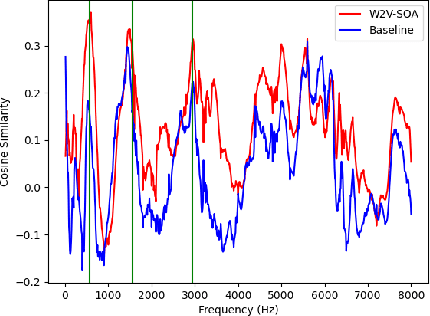Natarajan Balaji Shankar
CHSER: A Dataset and Case Study on Generative Speech Error Correction for Child ASR
May 24, 2025Abstract:Automatic Speech Recognition (ASR) systems struggle with child speech due to its distinct acoustic and linguistic variability and limited availability of child speech datasets, leading to high transcription error rates. While ASR error correction (AEC) methods have improved adult speech transcription, their effectiveness on child speech remains largely unexplored. To address this, we introduce CHSER, a Generative Speech Error Correction (GenSEC) dataset for child speech, comprising 200K hypothesis-transcription pairs spanning diverse age groups and speaking styles. Results demonstrate that fine-tuning on the CHSER dataset achieves up to a 28.5% relative WER reduction in a zero-shot setting and a 13.3% reduction when applied to fine-tuned ASR systems. Additionally, our error analysis reveals that while GenSEC improves substitution and deletion errors, it struggles with insertions and child-specific disfluencies. These findings highlight the potential of GenSEC for improving child ASR.
Selective Attention Merging for low resource tasks: A case study of Child ASR
Jan 14, 2025Abstract:While Speech Foundation Models (SFMs) excel in various speech tasks, their performance for low-resource tasks such as child Automatic Speech Recognition (ASR) is hampered by limited pretraining data. To address this, we explore different model merging techniques to leverage knowledge from models trained on larger, more diverse speech corpora. This paper also introduces Selective Attention (SA) Merge, a novel method that selectively merges task vectors from attention matrices to enhance SFM performance on low-resource tasks. Experiments on the MyST database show significant reductions in relative word error rate of up to 14%, outperforming existing model merging and data augmentation techniques. By combining data augmentation techniques with SA Merge, we achieve a new state-of-the-art WER of 8.69 on the MyST database for the Whisper-small model, highlighting the potential of SA Merge for improving low-resource ASR.
SOA: Reducing Domain Mismatch in SSL Pipeline by Speech Only Adaptation for Low Resource ASR
Jun 15, 2024



Abstract:Recently, speech foundation models have gained popularity due to their superiority in finetuning downstream ASR tasks. However, models finetuned on certain domains, such as LibriSpeech (adult read speech), behave poorly on other domains (child or noisy speech). One solution could be collecting as much labeled and diverse data as possible for joint finetuning on various domains. However, collecting target domain speech-text paired data and retraining the model is often costly and computationally expensive. In this paper, we introduce a simple yet effective method, speech only adaptation (SOA), based on speech foundation models (Wav2vec 2.0), which requires only speech input data from the target domain. Specifically, the Wav2vec 2.0 feature encoder is continually pretrained with the Wav2vec 2.0 loss on both the source and target domain data for domain adaptation, while the contextual encoder is frozen. Compared to a source domain finetuned model with the feature encoder being frozen during training, we find that replacing the frozen feature encoder with the adapted one provides significant WER improvements to the target domain while preserving the performance of the source domain. The effectiveness of SOA is examined on various low resource or domain mismatched ASR settings, including adult-child and clean-noisy speech.
Benchmarking Children's ASR with Supervised and Self-supervised Speech Foundation Models
Jun 15, 2024Abstract:Speech foundation models (SFMs) have achieved state-of-the-art results for various speech tasks in supervised (e.g. Whisper) or self-supervised systems (e.g. WavLM). However, the performance of SFMs for child ASR has not been systematically studied. In addition, there is no benchmark for child ASR with standard evaluations, making the comparisons of novel ideas difficult. In this paper, we initiate and present a comprehensive benchmark on several child speech databases based on various SFMs (Whisper, Wav2vec2.0, HuBERT, and WavLM). Moreover, we investigate finetuning strategies by comparing various data augmentation and parameter-efficient finetuning (PEFT) methods. We observe that the behaviors of these methods are different when the model size increases. For example, PEFT matches the performance of full finetuning for large models but worse for small models. To stabilize finetuning using augmented data, we propose a perturbation invariant finetuning (PIF) loss as a regularization.
 Add to Chrome
Add to Chrome Add to Firefox
Add to Firefox Add to Edge
Add to Edge